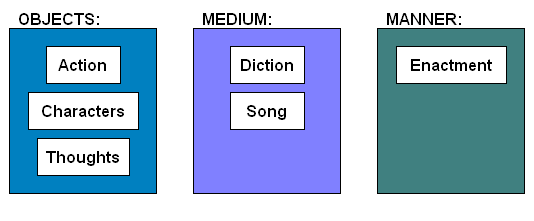
Aristotle's description of tragedy
In the interest of review and clarification, I would like to explore the common threads between the works we have explored this term. Points of interest include developing a theory both of what narrative is (its "substance") and how it is constructed (its "structure"). We will see how the major projects reviewed this term agree or disagree with these models. Also, we will briefly explore various project approaches at controlling narrative action.
Aristotle claimed that tragedy (a kind of narrative) has as its objects: action, characters, and thoughts. Its medium--how it is conveyed--is song and diction. Its manner is enactment. (Other forms, such as epics, have the manner of narration). (See Foundations of Interactive Narrative for more.) These can be charted as follows:

Aristotle's description of tragedy
Aristotle claims that Action is the end (as in "goal" or "essence") of tragedy. He proceeds to order the elements of tragedy above in order of their importance. Laurel, based on other neo-Aristotleans, has interpreted this ordering as evidence of formal and material causes between the levels:
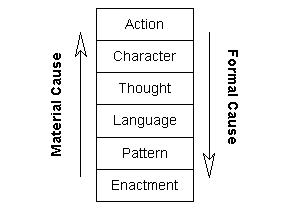
Laurel's extension of Aristotle
Laurel's model has, in turn, served as the basis of the Oz Project. In particular, Mateas has extended it in terms of interactivity. Incorporating Murray's notion of agency, he claims that "A player will experience agency when there is a balance between the material and formal constraints" (Mateas 2002). That is, while playing as a character in an interactive drama, a player will feel most effective when there is an agreement between the constraints of the story and the possible actions afforded them.
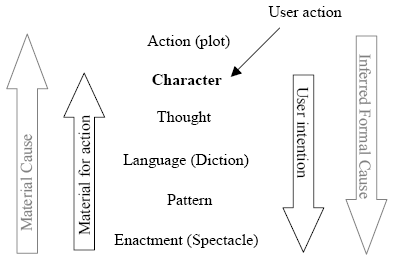
Mateas's extension of Laurel.
(Image from "Interactive Drama, Art, and Artificial Intelligence.")
As mentioned previously, I feel that Aristotle's original vision has been perverted through these extensions. While many of the extensions are useful, they create new tension, especially in the lower levels of the hierarchy. What is "pattern", exactly? It has been greatly modified from Aristotle's "song." This new hierarchy implies that we can understand characters only based on their thoughts, which in turn are only constructed in terms of language. Yet we can also understand characters by their actions, their mannerisms, their place in society, what others (including a narrator) may say of them. I believe that reinstating Aristotle's distinction between objects, medium, and manner could alleviate some of this strain while still allowing us to retain much of the progress we've gained.
Narratology divides a narrative into its story and its discourse. The story consists of a chronological series of causally-related events. The discourse is the telling of that story. The discourse, also called narration, may do such things as reorder the presentation of events or provide commentary on them. This may remind us of Meadows, who argues that the essence of narrative is perspective--conveying a certain point of view.
Seymour Chatman gives us a model of how this perspective is communicated. A real author produces a textual artifact, which a real reader later reads (or views, in the case of a film). The text contains certain constructs. The implied author can be considered the intent of the text, a background against which a narrator can be found to be "unreliable." Through these devices, we may find that a narrator holds one view while the text as a whole is espousing another. For instance, Mark Twain's Huckleberry Finn can be read as an anti-slavery text, even while its narrator, Huck Finn, believes that slavery is an appropriate norm. Thus, even without exploring the points-of-view of different characters, we find evidence that stories may involve multiple contrasting perspectives, yet, as a whole, deliver a certain view or commentary about the world.

Chatman's model.
This brings us to notions such as theme, as well as other meta-narrative concepts. For example, many narratives follow certain genre rules. Not inherent to the action or plot of the story, these meta-narrative concerns might better be placed within the domain of Freytag's Idea of the story--the author's over-arching conception which directs the molding and selecting of material into the unified action of the story.
With an eye towards constructing interactive narratives, I see four primary elements of all narratives: Action, Characters, Setting, and Perspective.
Certain terms, such as narrator and theater, appear as synonyms under more than one category. This is because term definitions depends on the particular project. Additionally, some projects subdivide or combine certain elements depending on their needs.
Setting is not mentioned, and certainly not stressed as important, in the other models we've seen. This is largely because these other models are based on Aristotle, who concerned himself with tragedies that were enacted with little to no scenery. As we begin to construct narratives in immersive, virtual worlds, we find that the rules and structure of the underlying world model becomes very important.
Meta-narrative concerns--such as theme or genre rules--do not yet have a designated place within this framework. They are an important part of the Perspective, but they also impact the construction of the Action; their "meta" nature implies that perhaps they are in fact external to all four elements, but influence them all.
With this proposed framework as a foundation, we can compare other project models.
The Oz Project has followed a practically identical model:
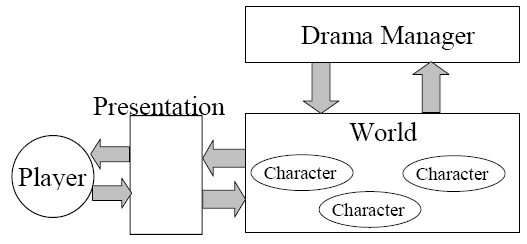
The Oz interactive drama architecture
(Image from "Interactive Drama, Art, and Artificial Intelligence.")
The only difference here is the reminder that characters exist and interact within the story world.
Grasbon and Braun provide an architecture comprising of four hierarchical levels, where the output of those above provide input for those below:
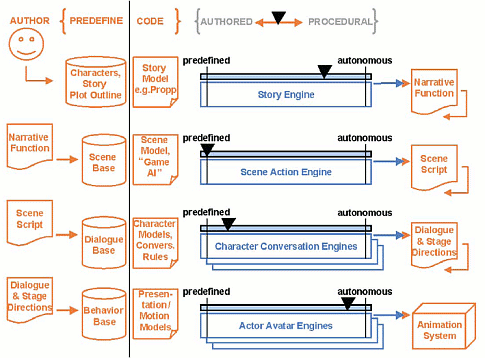
The Spierling, Grasbon, Braun, and Iurgel Model.
(Image from "Setting the Scene".)
We can see that they have divided story management into two levels: the management of the overall general (functional/morphological) structure and the construction of specific, instantiating scenes. Both the world model and presentation have been combined in the lowest layer.
The Virtual Storyteller project aims at developing an animated character who narrates stories. Though they mention characters' knowledge of their "virtual environment", they do not include this virtual world in their model:
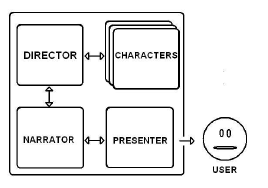
Theune, Faas, Nijholt, and Heylen model.
(Image from "The Virtual Storyteller.")
The characters' actions are directed by the "director" to produce a story. This project's "narrator" and "presenter" are both parts of our proposed Perspective element: the narrator rearranges story events and the presenter relates them to the user. Indeed, the Virtual Storyteller project is particularly interested in exploring the role of the narrator.
Szilas' IDtension project is interested in the effect of an audience model on interactive narrative.
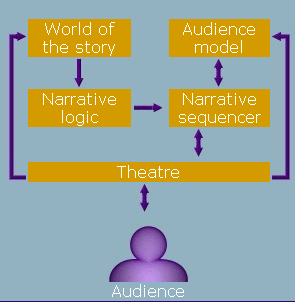
Szilas' IDtension model.
(Image from IDtension)
Characters are not shown in the model, but the "world of the story" includes characters (and their corresponding goals and actions). The "narrative logic" determines the set of actions possible at any given time. The "narrative sequencer" organizes dramatic actions based on the "audience model." The "theatre" presents the story and gathers interactions from the user. This project blurs the line somewhat between the Action and the Perspective elements of our proposed framework, but it is clear it is interested in exploring both, and shaping them in light of a user model.
As we have seen, our proposed framework provides a good overview of interactive narrative. Each project uses different terms and different divisions between architecture components. These architecture components are often subdivisions of the element of our framework that a certain project is particularly interested in exploring. A project may also combine two elements into a single component or ignore an element if it plays a marginal role in that project's particular focus.
Having established a working framework for the "substance" of narrative, we can now turn our attention to its structure. That is, how are plots constructed? In the past, we have looked at Aristotle's discussion of complete actions and Freytag's "triangle".
Of more recent interest is Vladimir Propp's Morphology of the Folktale, in which Propp outlines the "functions" common to Russian fairy tales. These functions occur is a consistent order across fairy tales, though not all functions are generally present in a single fairy tale. In addition, each function can have different specific instantiations. For instance, the function of an initial Villainy may take the form of a murder, a theft, or a kidnapping.
Propp's work is quite exciting in terms of story generation. He has clearly laid out the "rules" behind fairy tales. This confirms an intuition that there are general rules governing each genre--from film noir mysteries to science fiction horror. If we can codify these rules, as Propp has done for fairy tales, we should be able to use them to generate stories.
Though earlier interactive narrative work hoped for emergent narratives based on character interactions, later work has investigated more extensive story control. However, the extent and nature of this control varies greatly between projects.
Grasbon and Braun use a morphological approach based on Propp in their historical, interactive, augmented-reality system. They developed a drama manager that would select from a set of pre-constructed scenes based on particular criteria such as duration, context requirements, existing characters, etc. Certain scenes were polymorphic in that their outcome would be determined by user action.
The Oz drama manager, as described briefly by Mateas (1997) and Bates (1992), uses a similar approach. An Oz author creates a story of points (scenes or pivotal actions) and then an evaluation function that will rank different permutations of these story points. During interaction, the drama manager responds to each user move from one plot point to another by analyzing all possible user and system moves, and ranks all resulting permutations according to the evaluation function. Based on the results, the system makes a move most likely to result in the best story. This is a chess-like, adversary search approach. Instead of using scenes to instantiate ordered Proppian functions, the scenes are ordered directly.
Mateas, in constructing Facade, modifies this approach with the implementation of beats. Beats are short segments of action; they may be clustered into larger scenes. A drama/beat manager selects beats based on their defined effects on particular variables (such as tension or affinity) by which the author has defined the story arc. Beat selection is also affected by whether its preconditions have been met and by its weighting compared to otherwise equivalent beats. Some beats may be polyvalent--their outcome is unknown at initialization, probably because it depends on a user choice made during the beat. Beats may also potentially be interrupted by user action before they complete.
Theune, Faas, Nijholt & Heylen's "director" uses story knowledge to guide characters and proscribe certain actions. This director does not start with a preexisting plot, but generates it on-the-fly, as influenced by the characters. Currently rather basic, it is intended that this director will eventually use a Proppian-like story knowledge.
Other projects, such as Sgouros' DeFacto and Crawford's Erasmatron, focus instead on the simulation of social interaction between characters. Although both refer to story management, any "drama manager" is either rather minimal or primarily intended to be inherent in and/or emergent from the rules of interaction.
There exists a variety of theoretical models used by current interactive narrative projects. However, using a general model dividing narratives into Action, Characters, Setting, and Presentation elements, we can see many basic similarities between these same projects. Assuming, as Aristotle claimed, that Action is the primary end of drama, we have also seen a variety of approaches at interactively managing this action. The most successful of these seem to be those projects that attempt to dynamically order a collection of pre-existing story elements--whether these be called scenes, plot points, or beats.
Aristotle. Poetics. Translated: S. H. Butcher. Introduction: Francis Fergusson. New York: Hill and Wang, 1961.
Bates, Joseph. "Virtual Reality, Art, and Entertainment." Presence: The Journal of Teleoperators and Virtual Environments. 1(1):133-138, MIT Press, Winter 1992.
Chatman, Seymour. Coming to Terms: The Rhetoric of Narrative in Fiction and Film. Ithaca: Cornell University Press, 1990. Crawford, Chris. http://www.erasmatazz.com/>
Freytag, Gustav. Technique of the Drama. Translated: Elias J. MacEwan, from 6th German edition. Chicago: S.C. Griggs & Company, 1895.
Grasbon, Dieter, and Norbert Braun. "A Morphological Approach to Interactive Storytelling." Digital Storytelling Department, Computer Graphics Center, Darmstadt, Germany, 2001. <http://netzspannung.org/version1/extensions/ cast01-proceedings/pdf/by_name/Grasbon.pdf >
Laurel, Brenda. Computers as Theatre. Reading, Mass: Addison-Wesley Publishing Co., 1991.
Mateas, Michael. An Oz-Centric Review of Interactive Drama and Believable Agents. Technical Report CMU-CS-97-156, School of Computer Science, Carnegie Mellon University, Pittsburgh, PA. June 1997.
Mateas, Michael. "Interactive Drama, Art, and Artificial Intelligence." Ph.D. Thesis. Technical Report CMU-CS-02-206, School of Computer Science, Carnegie Mellon University, Pittsburgh, PA. December 2002. <http://www.cs.cmu.edu/afs/cs/project/oz/web/papers/CMU-CS-02-206.pdf>
Murray, Janet. Hamlet on the Holodeck: The Future of Narrative in Cyberspace. New York: Free Press, 1997.
Meadows, Mark Stephens. Pause & Effect: The Art of Interactive Narrative. Indianapolis, IN: New Riders, 2003.
Propp, Vladimir. Morphology of the Folktale. 2nd edition. Ed. Louis A. Wagner. Austin, TX: Unveristy of Texas Press, 1968.
Sgouros, Nikitas M. "Dynamic generation, management, and resolution of interactive plots." Artificial Intelligence 107 (1999) 29-62.
Spierling, Ulrike, and Dieter Grasbon, Norbert Braun, Ido Iurgel. "Setting the scene: playing digital director in interactive storytelling and creation." Computers & Graphics 26 (2002) 31-44. <http://www.zgdv.de/zgdv/files/zgdv/departments/z5/Z5Publications/2002_02/document.pdf>
Theune, Mariet, and Sander Faas, Anton Nijholt, Dirk Heylen. "The Virtual Storyteller: Story Creation by Intelligent Agents." 2003. <http://wwwhome.cs.utwente.nl/~anijholt/artikelen/tidse2003.pdf>
| ~ztomasze Index:
CIS: 699 http://www2.hawaii.edu/~ztomasze |
Last Edited: 15 Dec 2005 ©2005 by Z. Tomaszewski. |